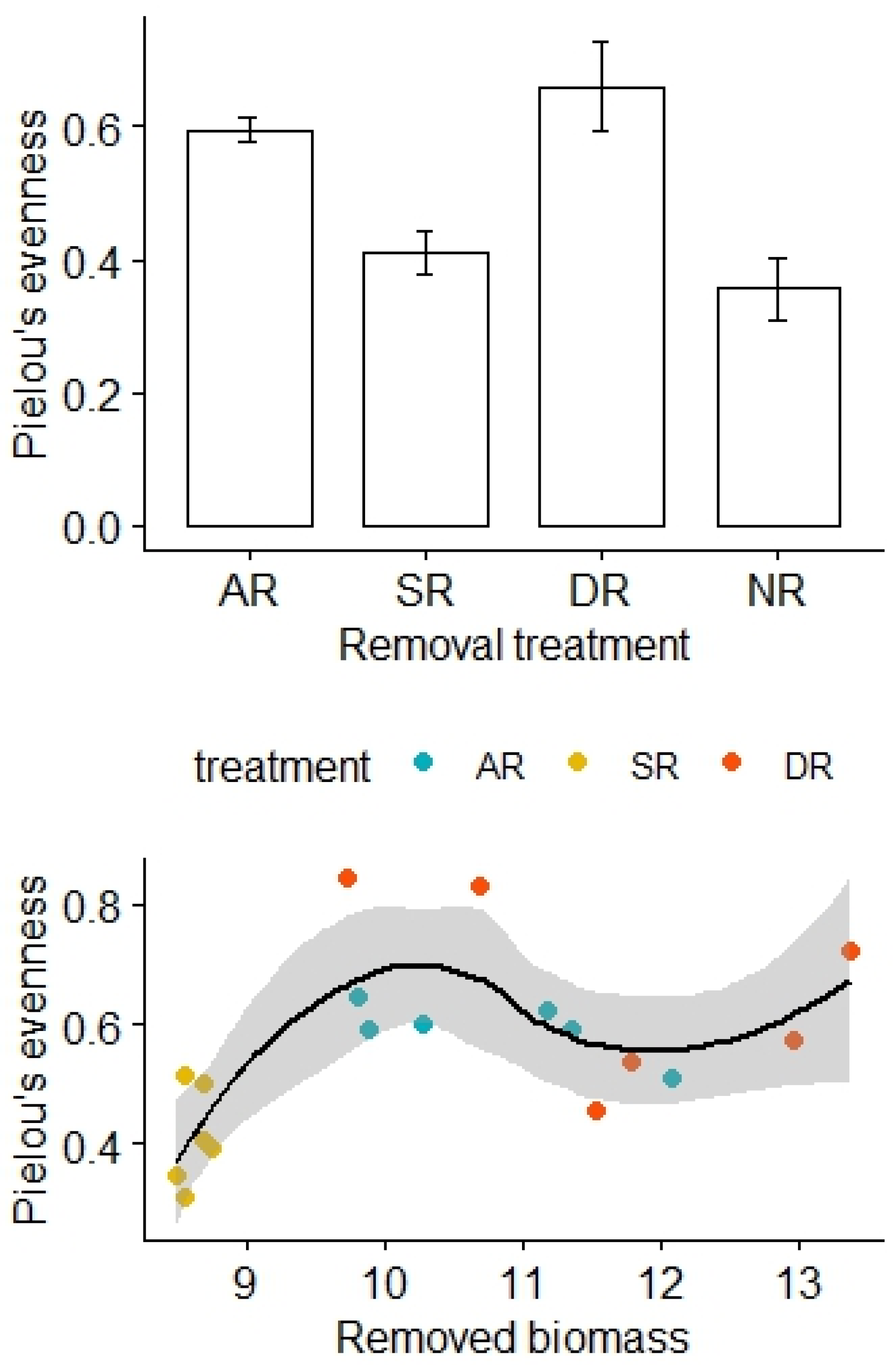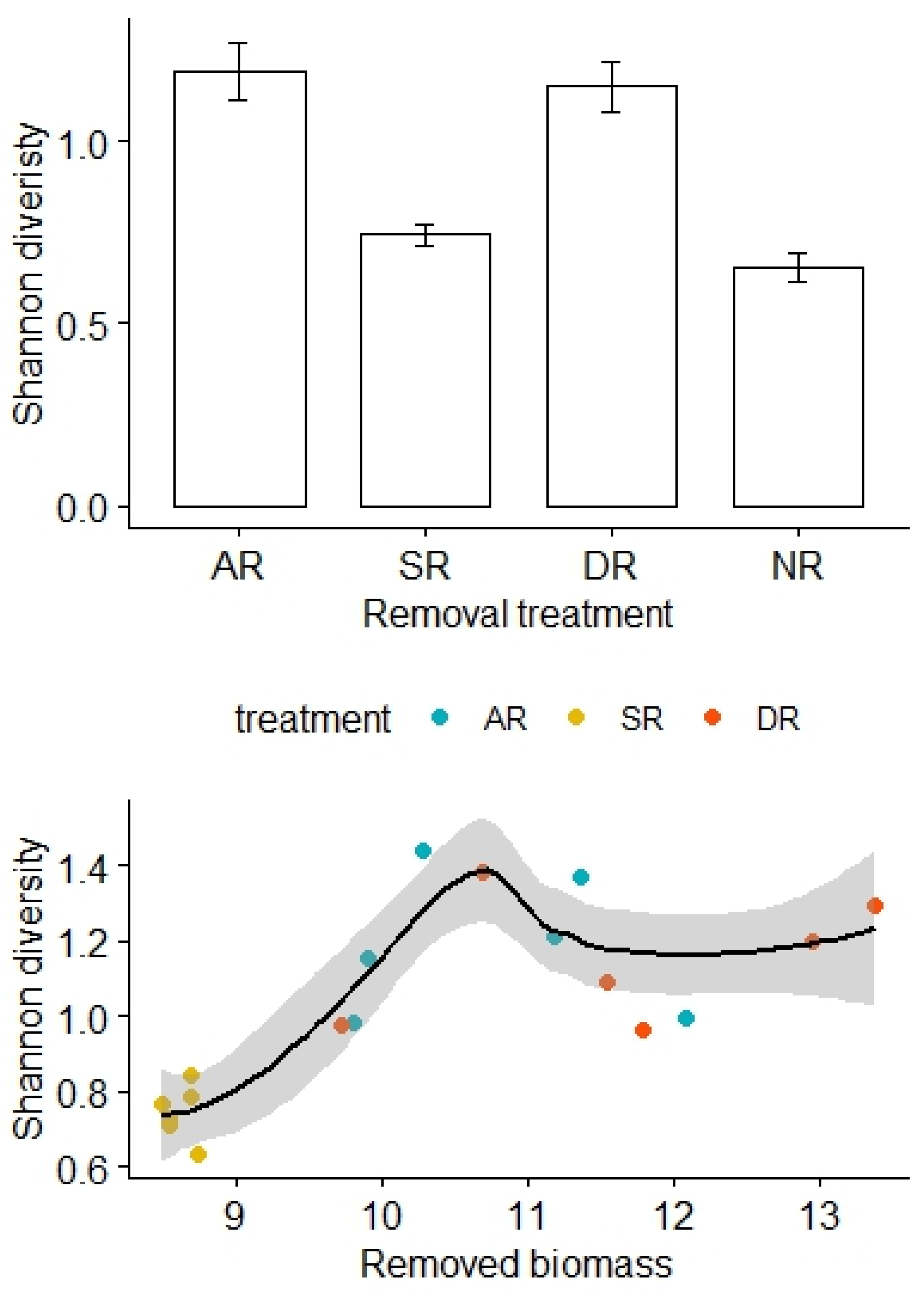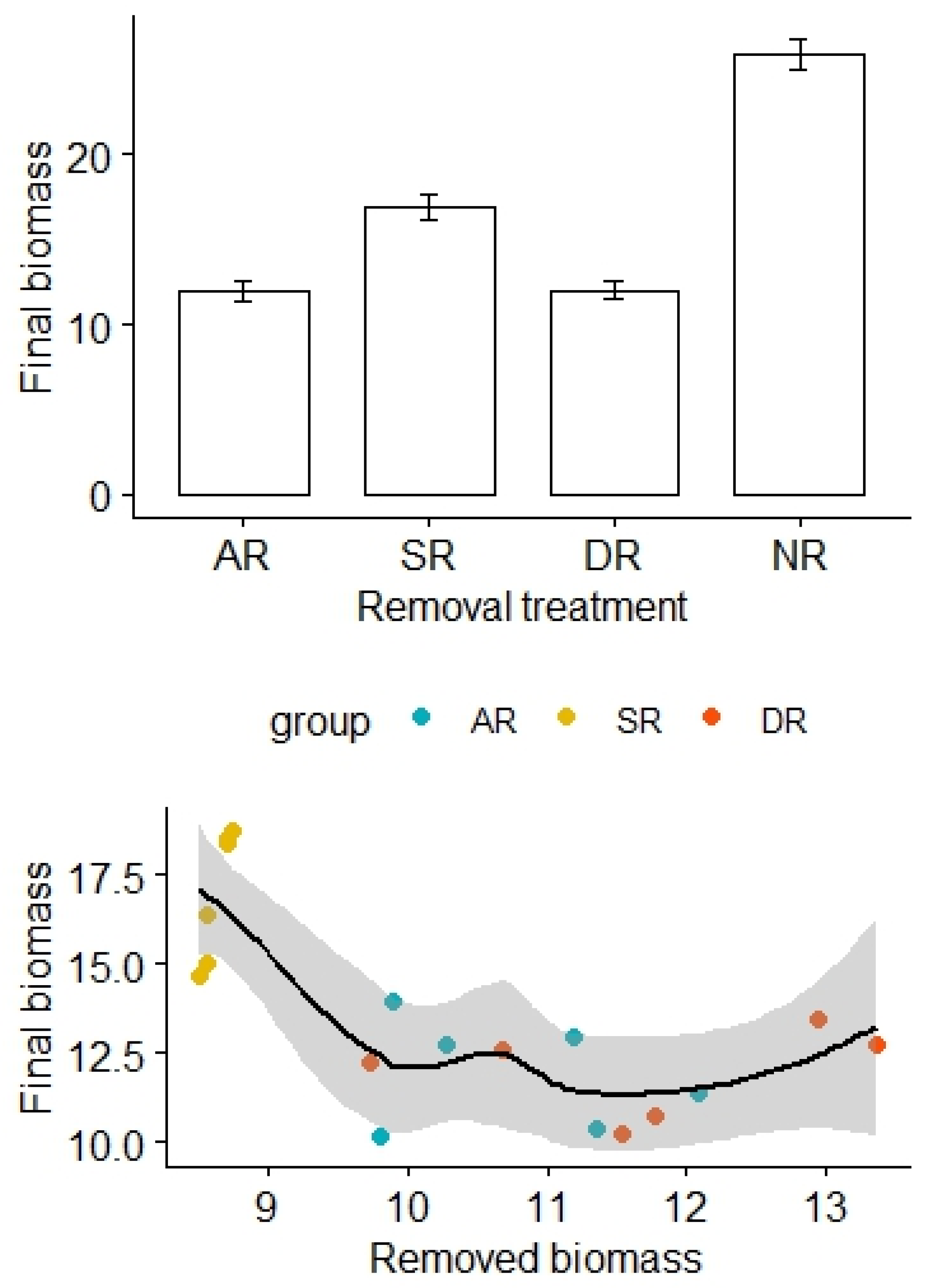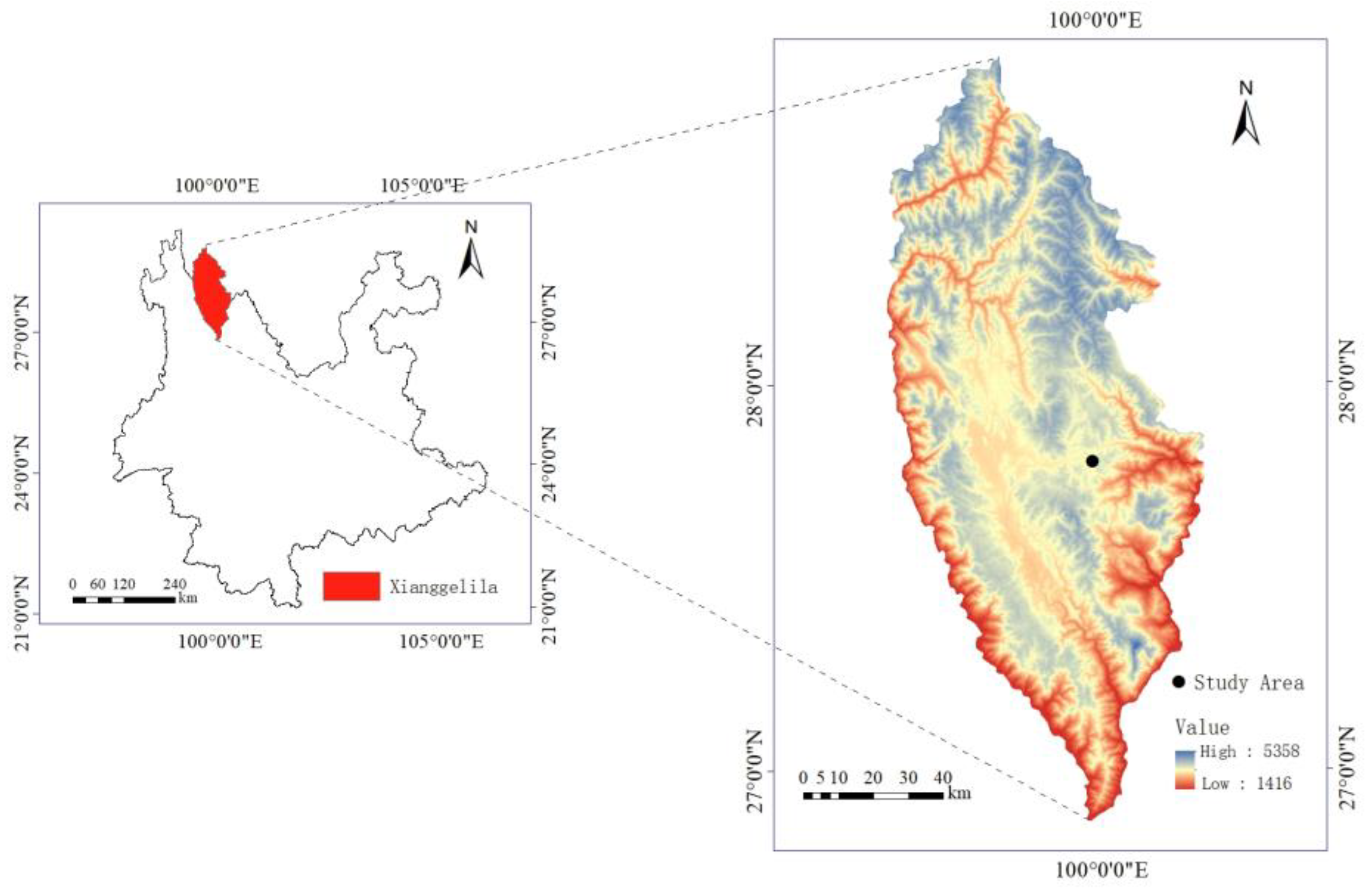Short-Term Responses of Alpine Vegetation to the Removal of Dominant versus Sparse Species
Abstract
1. Introduction
2. Results
3. Discussion
4. Materials and Methods
4.1. Study Area
4.2. Experimental Design
4.3. Biodiversity and Soil Chemical Characterization
4.4. Statistical Analysis
5. Conclusions
Author Contributions
Funding
Data Availability Statement
Acknowledgments
Conflicts of Interest
References
- Grime, J.P. Benefits of plant diversity to ecosystems: Immediate, filter and founder effects. J. Ecol. 1998, 86, 902–910. [Google Scholar] [CrossRef]
- Gilbert, B.; Turkington, R.; Srivastava, D.S. Dominant Species and Diversity: Linking Relative Abundance to Controls of Species Establishment. Am. Nat. 2009, 174, 850–862. [Google Scholar] [CrossRef] [PubMed]
- Miles, E.K.; Knops, J.M. Shifting dominance from native C4 to non-native C3 grasses: Relationships to community diversity. Oikos 2009, 118, 1844–1853. [Google Scholar] [CrossRef]
- Avolio, M.L.; Forrestel, E.J.; Chang, C.C.; La Pierre, K.J.; Burghardt, K.T.; Smith, M.D. Demystifying dominant species. New Phytol. 2019, 223, 1106–1126. [Google Scholar] [CrossRef] [PubMed]
- Wardle, D.A.; Bonner, K.I.; Barker, G.; Yeates, G.W.; Nicholson, K.S.; Bardgett, R.D.; Watson, R.; Ghani, A. plant removals in perennial grassland: Vegetation dynamics, decomposers, soil biodiversity, and ecosystem properties. Ecol. Monogr. 1999, 69, 535–568. [Google Scholar] [CrossRef]
- Munson, S.M.; Lauenroth, W.K. Plant population and community responses to removal of dominant species in the shortgrass steppe. J. Veg. Sci. 2009, 20, 224–232. [Google Scholar] [CrossRef]
- Akatov, V.V.; Akatova, T.V.; Afanasyev, D.F.; Eskina, T.G.; Sazonets, N.M.; Sushkova, E.G.; Chefranov, S.G. Effect of Dominants on the Species Richness of Plant Communities in the Context of the Species–Energy Hypothesis. Biol. Bull. Rev. 2023, 13, 238–246. [Google Scholar] [CrossRef]
- Pinto, S.M.; Pearson, D.E.; Maron, J.L. Seed dispersal is more limiting to native grassland diversity than competition or seed predation. J. Ecol. 2014, 102, 1258–1265. [Google Scholar] [CrossRef]
- Arnillas, C.A.; Cadotte, M.W. Experimental dominant plant removal results in contrasting assembly for dominant and non-dominant plants. Ecol. Lett. 2019, 22, 1233–1242. [Google Scholar] [CrossRef] [PubMed]
- Arnillas, C.A.; Borer, E.T.; Seabloom, E.W.; Alberti, J.; Baez, S.; Bakker, J.D.; Boughton, E.H.; Buckley, Y.M.; Bugalho, M.N.; Donohue, I.; et al. Opposing community assembly patterns for dominant and nondominant plant species in herbaceous ecosystems globally. Ecol. Evol. 2021, 11, 17744–17761. [Google Scholar] [CrossRef] [PubMed]
- Schumacher, J.; Roscher, C. Differential effects of functional traits on aboveground biomass in semi-natural grasslands. Oikos 2009, 118, 1659–1668. [Google Scholar] [CrossRef]
- Hu, Y.; Bao, R.; Shi, L.; Wang, J.-K.; Wang, J.; Wang, L.; Li, Y. Analysis of population structure of Blysmus sinocompressus in the Qilian Mountains by ISSR markers. Aquat. Bot. 2016, 134, 54–60. [Google Scholar] [CrossRef]
- Henderson, P.A.; Magurran, A.E. Linking species abundance distributions in numerical abundance and biomass through simple assumptions about community structure. Proc. R. Soc. B Biol. Sci. 2010, 277, 1561–1570. [Google Scholar] [CrossRef] [PubMed]
- Bricelj, V.M.; Grant, J.; Anderson, D.; Archambault, M. Effects of suspended and sedimented clays on juvenile hard clams, Mercenaria mercenaria, within the context of harmful algal bloom mitigation. Mar. Biol. 2004, 144, 553–565. [Google Scholar] [CrossRef]
- Gorzelnik, S.A.; Zhu, X.; Angelidaki, I.; Koski, M.; Valverde-Pérez, B. Daphnia magna as biological harvesters for green microalgae grown on recirculated aquaculture system effluents. Sci. Total Environ. 2023, 873, 162247. [Google Scholar] [CrossRef] [PubMed]
- Pinto, S.M. Causes and Consequences of Dominance and Diversity in Grasslands; University of Montana: Missoula, MT, USA, 2013. [Google Scholar]
- Ward, D.; Kirkman, K.P.; Morris, C.D. Long-term subtropical grassland plots take a long time to change: Replacement is more important than richness differences for beta diversity. Ecol. Evol. 2023, 13. [Google Scholar] [CrossRef]
- Feng, H.; Squires, V.R. Socio-environmental dynamics of alpine grasslands, steppes and meadows of the Qinghai–Tibetan Plateau, China: A commentary. Appl. Sci. 2020, 10, 6488. [Google Scholar] [CrossRef]
- Wang, C.; Wang, G.; Liu, W.; Wu, P. The Effects of Plant-Soil-Enzyme Interactions on Plant Composition, Biomass and Diversity of Alpine Meadows in the Qinghai-Tibetan Plateau. Int. J. Ecol. 2011, 2011, 180926. [Google Scholar] [CrossRef]
- Wasof, S.; Lenoir, J.; Hattab, T.; Jamoneau, A.; Gallet-Moron, E.; Ampoorter, E.; Saguez, R.; Bennsadek, L.; Bertrand, R.; Valdès, A.; et al. Dominance of individual plant species is more important than diversity in explaining plant biomass in the forest understorey. J. Veg. Sci. 2018, 29, 521–531. [Google Scholar] [CrossRef]
- McLaren, J.R.; Turkington, R. Biomass compensation and plant responses to 7 years of plant functional group removals. J. Veg. Sci. 2011, 22, 503–515. [Google Scholar] [CrossRef]
- Eckberg, J.N.; Hubbard, A.; Schwarz, E.T.; Smith, E.T.; Sanders, N.J. The dominant plant species Solidago canadensis structures multiple trophic levels in an old-field ecosystem. Ecosphere 2023, 14, e4393. [Google Scholar] [CrossRef]
- McCain, K.N.; Baer, S.G.; Blair, J.M.; Wilson, G. Dominant Grasses Suppress Local Diversity in Restored Tallgrass Prairie. Restor. Ecol. 2010, 18, 40–49. [Google Scholar] [CrossRef]
- Čaušević, S.; Dubey, M.; Morales, M.; Salazar, G.; Sentchilo, V.; Carraro, N.; Ruscheweyh, H.-J.; Sunagawa, S.; van der Meer, J.R. Niche availability and competitive loss by facilitation control proliferation of bacterial strains intended for soil microbiome interventions. Nat. Commun. 2024, 15, 2557. [Google Scholar] [CrossRef] [PubMed]
- Valdez, J.W.; Callaghan, C.T.; Junker, J.; Purvis, A.; Hill, S.L.; Pereira, H.M. The undetectability of global biodiversity trends using local species richness. Ecography 2023, 2023, e06604. [Google Scholar] [CrossRef]
- Niu, G.; Hasi, M.; Wang, R.; Wang, Y.; Geng, Q.; Hu, S.; Xu, X.; Yang, J.; Wang, C.; Han, X.; et al. Soil microbial community responses to long-term nitrogen addition at different soil depths in a typical steppe. Appl. Soil Ecol. 2021, 167, 104054. [Google Scholar] [CrossRef]
- Lohbeck, M.; Poorter, L.; Martínez-Ramos, M.; Bongers, F. Biomass is the main driver of changes in ecosystem process rates during tropical forest succession. Ecology 2015, 96, 1242–1252. [Google Scholar] [CrossRef] [PubMed]
- Collins, C.G.; Elmendorf, S.C.; Smith, J.G.; Shoemaker, L.; Szojka, M.; Swift, M.; Suding, K.N. Global change re-structures alpine plant communities through interacting abiotic and biotic effects. Ecol. Lett. 2022, 25, 1813–1826. [Google Scholar] [CrossRef] [PubMed]
- Pan, Q.; Tian, D.; Naeem, S.; Auerswald, K.; Elser, J.J.; Bai, Y.; Huang, J.; Wang, Q.; Wang, H.; Wu, J.; et al. Effects of functional diversity loss on ecosystem functions are influenced by compensation. Ecology 2016, 979, 2293–2302. [Google Scholar] [CrossRef] [PubMed]
- Li, W.; Zhang, R.; Liu, S.; Li, W.; Li, J.; Zhou, H.; Knops, J.M. Effect of loss of plant functional group and simulated nitrogen deposition on subalpine ecosystem properties on the Tibetan Plateau. Sci. Total Environ. 2018, 631–632, 289–297. [Google Scholar] [CrossRef] [PubMed]
- Elumeeva, T.G.; Onipchenko, V.G.; Werger, M.J. No other species can replace them: Evidence for the key role of dominants in an alpine Festuca varia grassland. J. Veg. Sci. 2017, 28, 674–683. [Google Scholar] [CrossRef]
- McLaren, J.R.; Turkington, R. Ecosystem properties determined by plant functional group identity. J. Ecol. 2010, 98, 459–469. [Google Scholar] [CrossRef]
- Spence, A.R.; Tingley, M.W. The challenge of novel abiotic conditions for species undergoing climate-induced range shifts. Ecography 2020, 43, 1571–1590. [Google Scholar] [CrossRef]
- Crawford, M.S.; Barry, K.E.; Clark, A.T.; Farrior, C.E.; Hines, J.; Ladouceur, E.; Lichstein, J.W.; Maréchaux, I.; May, F.; Mori, A.S.; et al. The function-dominance correlation drives the direction and strength of biodiversity–ecosystem functioning relationships. Ecol. Lett. 2021, 24, 1762–1775. [Google Scholar] [CrossRef] [PubMed]
- Wang, C.; Long, R.; Wang, Q.; Liu, W.; Jing, Z.; Zhang, L.J. Fertilization and litter effects on the functional group biomass, species diversity of plants, microbial biomass, and enzyme activity of two alpine meadow communities. Plant Soil 2010, 331, 377–389. [Google Scholar] [CrossRef]
- Chaves, F.A.; Smith, M.D. Resources do not limit compensatory response of a tallgrass prairie plant community to the loss of a dominant species. J. Ecol. 2020, 109, 3617–3633. [Google Scholar] [CrossRef]
- Jain, M.; Flynn, D.F.; Prager, C.M.; Hart, G.M.; DeVan, C.M.; Ahrestani, F.S.; Palmer, M.I.; Bunker, D.E.; Knops, J.M.; Jouseau, C.F.; et al. The importance of rare species: A trait-based assessment of rare species contributions to functional diversity and possible ecosystem function in tall-grass prairies. Ecol. Evol. 2014, 4, 104–112. [Google Scholar] [CrossRef]
- Wang, W.; Ma, Y.; Xu, J.; Wang, H.; Zhu, J.; Zhou, H. The uptake diversity of soil nitrogen nutrients by main plant species in Kobresia humilis alpine meadow on the Qinghai-Tibet Plateau. Sci. China Earth Sci. 2012, 55, 1688–1695. [Google Scholar] [CrossRef]
- Li, W.; He, S.; Cheng, X.; Zhang, M. Functional diversity outperforms taxonomic diversity in revealing short-term trampling effects. Sci. Rep. 2021, 11, 18889. [Google Scholar] [CrossRef] [PubMed]
- Pan, J.; Wang, J.; Gao, F.; Liu, G. Quantitative estimation and influencing factors of ecosystem soil conservation in Shangri-La, China. Geocarto Int. 2022, 37, 14828–14842. [Google Scholar] [CrossRef]
- Li, W.; Cheng, J.; Yu, K.; Epstein, H.E.; Du, G. Short-term responses of an alpine meadow community to removal of a dominant species along a fertilization gradient. J. Plant Ecol. 2015, 8, 513–522. [Google Scholar] [CrossRef]
- Steinbauer, K.; Lamprecht, A.; Winkler, M.; Di Cecco, V.; Fasching, V.; Ghosn, D.; Maringer, A.; Remoundou, I.; Suen, M.; Stanisci, A.; et al. Recent changes in high-mountain plant community functional composition in contrasting climate regimes. Sci. Total Environ. 2022, 829, 154541. [Google Scholar] [CrossRef]





| SS | df | MS | F | p | |
|---|---|---|---|---|---|
| Removed biomass | 895.5 | 1 | 895.5 | 84.84 | <0.01 * |
| Treatment | 706.1 | 2 | 353 | 33.45 | <0.01 * |
| Removed biomass/Treatment | 21.7 | 2 | 10.9 | 1.03 | 0.387 |
| Residuals | 126.7 | 12 | 10.6 |
| SS | df | MS | F | p | |
|---|---|---|---|---|---|
| Removed biomass | 0.072 | 1 | 0.072 | 6.301 | 0.027 * |
| Treatment | 0.159 | 2 | 0.079 | 6.90 | 0.01 * |
| Removed biomass/Treatment | 0.005 | 2 | 0.003 | 0.215 | 0.809 |
| Residuals | 0.138 | 12 | 0.012 |
| SS | df | MS | F | p | |
|---|---|---|---|---|---|
| Removed biomass | 0.509 | 1 | 0.509 | 18.327 | <0.001 * |
| Treatment | 0.233 | 2 | 0.117 | 4.195 | 0.031 * |
| Removed biomass/Treatment | 0.008 | 2 | 0.004 | 0.137 | 0.873 |
| Residuals | 0.333 | 12 | 0.028 |
| SS | df | MS | F | p | |
|---|---|---|---|---|---|
| Removed biomass | 58.83 | 1 | 58.83 | 36.25 | <0.01 * |
| Treatment | 40.74 | 2 | 20.37 | 12.55 | <0.01 * |
| Removed biomass/Treatment | 16.85 | 2 | 8.42 | 5.19 | 0.02 * |
| Residuals | 19.48 | 12 | 1.62 |
| SS | df | MS | F | p | |
|---|---|---|---|---|---|
| Removed biomass | 18.58 | 1 | 18.58 | 0.50 | 0.49 |
| Treatment | 78.5 | 2 | 39.27 | 1.06 | 0.38 |
| Removed biomass/Treatment | 14.6 | 2 | 7.31 | 0.20 | 0.82 |
| Residuals | 444.8 | 12 | 37.07 |
| SS | df | MS | F | p | |
|---|---|---|---|---|---|
| Removed biomass | 0.0061 | 1 | 0.0061 | 0.04 | 0.85 |
| Treatment | 0.5447 | 2 | 0.2724 | 1.74 | 0.22 |
| Removed biomass/Treatment | 0.2391 | 2 | 0.1195 | 0.76 | 0.49 |
| Residuals | 1.8825 | 12 | 0.1569 |
Disclaimer/Publisher’s Note: The statements, opinions and data contained in all publications are solely those of the individual author(s) and contributor(s) and not of MDPI and/or the editor(s). MDPI and/or the editor(s) disclaim responsibility for any injury to people or property resulting from any ideas, methods, instructions or products referred to in the content. |
© 2024 by the authors. Licensee MDPI, Basel, Switzerland. This article is an open access article distributed under the terms and conditions of the Creative Commons Attribution (CC BY) license (https://creativecommons.org/licenses/by/4.0/).
Share and Cite
Wang, W.; Li, W. Short-Term Responses of Alpine Vegetation to the Removal of Dominant versus Sparse Species. Plants 2024, 13, 1756. https://doi.org/10.3390/plants13131756
Wang W, Li W. Short-Term Responses of Alpine Vegetation to the Removal of Dominant versus Sparse Species. Plants. 2024; 13(13):1756. https://doi.org/10.3390/plants13131756
Chicago/Turabian StyleWang, Weichao, and Wei Li. 2024. "Short-Term Responses of Alpine Vegetation to the Removal of Dominant versus Sparse Species" Plants 13, no. 13: 1756. https://doi.org/10.3390/plants13131756
APA StyleWang, W., & Li, W. (2024). Short-Term Responses of Alpine Vegetation to the Removal of Dominant versus Sparse Species. Plants, 13(13), 1756. https://doi.org/10.3390/plants13131756





